A special case of the normal distribution has mean \(\mu = 0\) and a variance of \(\sigma^2 = 1\). The 'standard normal' is an important distribution.
Standard Normal Distribution
A standard normal distribution has a mean of 0 and variance of 1. This is also known as a z distribution. You may see the notation \(N(\mu, \sigma^2\)) where N signifies that the distribution is normal, \(\mu\) is the mean, and \(\sigma^2\) is the variance. A Z distribution may be described as \(N(0,1)\). Note that since the standard deviation is the square root of the variance then the standard deviation of the standard normal distribution is 1.
Finding Probabilities of a Standard Normal Random Variable Section
As we mentioned previously, calculus is required to find the probabilities for a Normal random variable. Fortunately, we have tables and software to help us.
For any normal random variable, we can transform it to a standard normal random variable by finding the Z-score. Then we can find the probabilities using the standard normal tables.
Most statistics books provide tables to display the area under a standard normal curve. Look in the appendix of your textbook for the Standard Normal Table. We include a similar table, the Standard Normal Cumulative Probability Table so that you can print and refer to it easily when working on the homework.
Most standard normal tables provide the “less than probabilities”. For example, if \(Z\) is a standard normal random variable, the tables provide \(P(Z\le a)=P(Z<a)\), for a constant, \(a\).
Example 3-9: Probability 'less than' Section
Find the area under the standard normal curve to the left of 0.87.
There are two main ways statisticians find these numbers that require no calculus! Click on the tabs below to see how to answer using a table and using technology.
A typical four-decimal-place number in the body of the Standard Normal Cumulative Probability Table gives the area under the standard normal curve that lies to the left of a specified z-value. The probability to the left of z = 0.87 is 0.8078 and it can be found by reading the table:
- Since z = 0.87 is positive, use the table for POSITIVE z-values.
- Go down the left-hand column, label z to "0.8."
- Then, go across that row until under the "0.07" in the top row.
You should find the value, 0.8078. Therefore,\(P(Z< 0.87)=P(Z\le 0.87)=0.8078\)
z | .00 | .01 | .02 | .03 | .04 | .05 | .06 | .07 | .08 | .09 |
|---|---|---|---|---|---|---|---|---|---|---|
0.6 | .7257 | .7291 | .7324 | .7357 | .7389 | .7422 | .7454 | .7586 | .7517 | .7549 |
0.7 | .7580 | .7611 | .7642 | .7673 | .7704 | .7734 | .7764 | .7794 | .7823 | .7852 |
0.8 | .7881 | .7910 | .7939 | .7967 | .7995 | .8023 | .8051 | .8078 | .8106 | .8133 |
0.9 | .8159 | .8186 | .8212 | .8238 | .8264 | .8289 | .8315 | .8340 | .8365 | .8389 |
Using Minitab
To find the area to the left of z = 0.87 in Minitab...
- From the Minitab menu select Calc> Probability Distributions> Normal.
- Select Cumulative Probability.
- In the Input constant box, enter 0.87. Click OK

You should see a value very close to 0.8078.
Example 3-10: Probability 'greater than' Section
Find the area under the standard normal curve to the right of 0.87.
Based on the definition of the probability density function, we know the area under the whole curve is one. Since we are given the “less than” probabilities in the table, we can use complements to find the “greater than” probabilities. Therefore,
\(P(Z>0.87)=1-P(Z\le 0.87)\).
Using the information from the last example, we have \(P(Z>0.87)=1-P(Z\le 0.87)=1-0.8078=0.1922\)
Using Minitab
Since we are given the “less than” probabilities when using the cumulative probability in Minitab, we can use complements to find the “greater than” probabilities. Therefore,
\(P(Z>0.87)=1-P(Z\le 0.87)\).
Using the information from the last example, we have \(P(Z>0.87)=1-P(Z\le 0.87)=1-0.8078=0.1922\)
You can also use the probability distribution plots in Minitab to find the "greater than."
- Select Graph> Probability Distribution Plot> View Probability and click OK.
- In the pop-up window select the Normal distribution with a mean of 0.0 and a standard deviation of 1.0.
- Select the Shaded Area tab at the top of the window.
- Select X Value.
- Enter 0.87 for X value.
- Select Right Tail.
- Click OK.
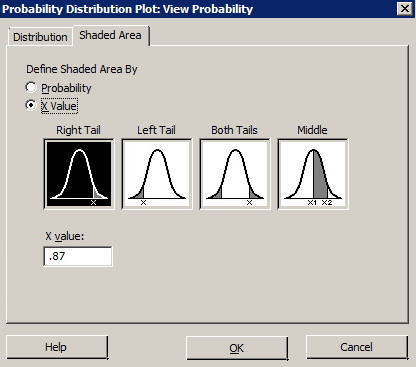
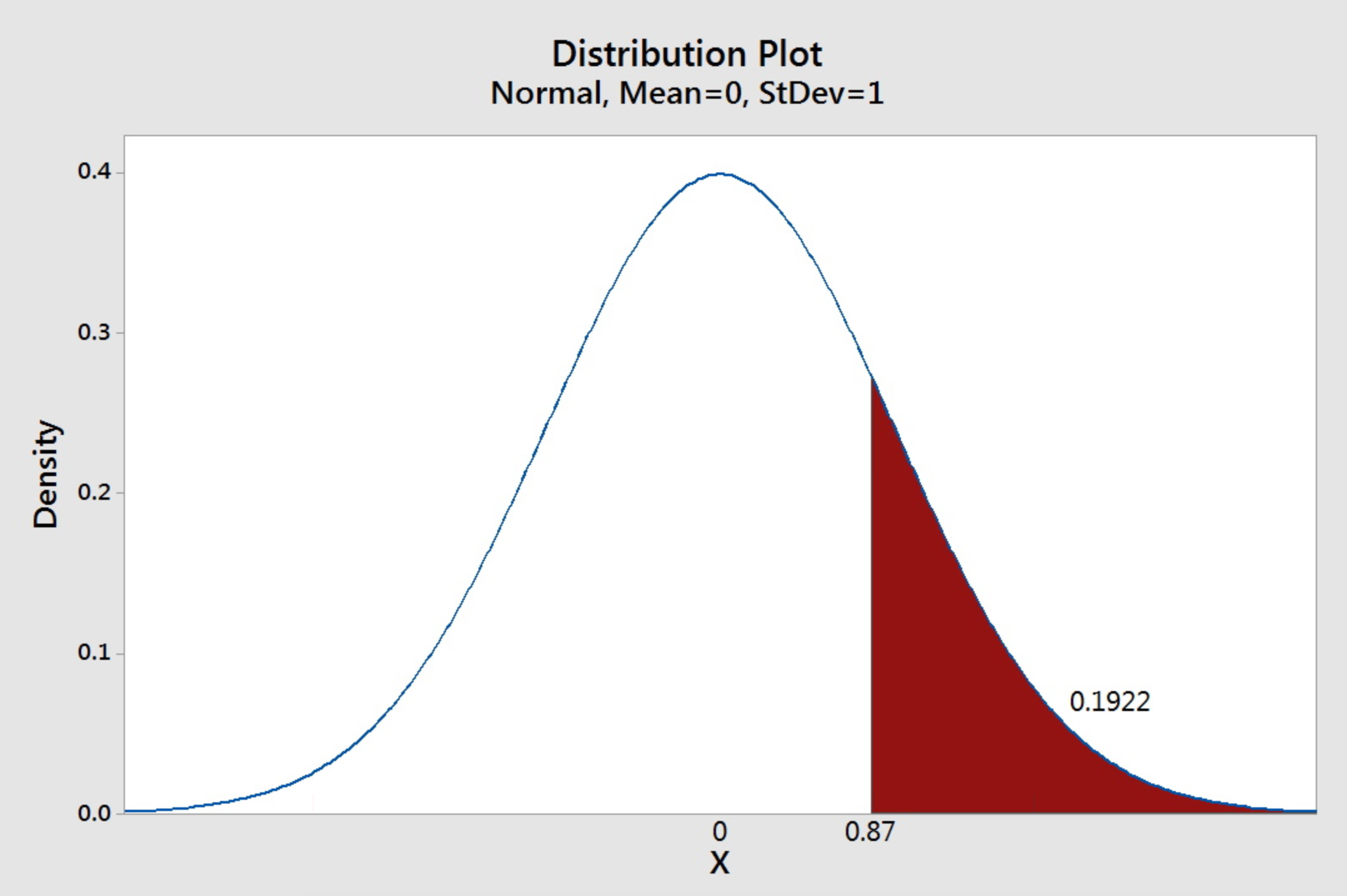
Example 3-11: Probability 'between' Section
Find the area under the standard normal curve between 2 and 3.
To find the probability between these two values, subtract the probability of less than 2 from the probability of less than 3. In other words,
\(P(2<Z<3)=P(Z<3)-P(Z<2)\)
\(P(Z<3)\) and \(P(Z<2)\) can be found in the table by looking up 2.0 and 3.0.
For 3.0...
z | .00 | .01 | .02 | .03 | .04 | .05 | .06 | .07 | .08 | .09 |
|---|---|---|---|---|---|---|---|---|---|---|
2.8 | 0.9974 | 0.9975 | 0.9976 | 0.9977 | 0.9977 | 0.9978 | 0.9979 | 0.9979 | 0.9980 | 0.9980 |
2.9 | 0.9981 | 0.9982 | 0.9982 | 0.9983 | 0.9984 | 0.9984 | 0.9985 | 0.9985 | 0.9986 | 0.9986 |
3.0 | 0.9987 | 0.9987 | 0.9987 | 0.9988 | 0.9988 | 0.9989 | 0.9989 | 0.9989 | 0.9990 | 0.9990 |
3.1 | 0.9990 | 0.9991 | 0.9991 | 0.9991 | 0.9992 | 0.9992 | 0.9992 | 0.9992 | 0.9993 | 0.9993 |
For 2.0...
z | .00 | .01 | .02 | .03 | .04 | .05 | .06 | .07 | .08 | .09 |
|---|---|---|---|---|---|---|---|---|---|---|
1.8 | 0.9641 | 0.9649 | 0.9656 | 0.9664 | 0.9671 | 0.9678 | 0.9686 | 0.9693 | 0.9699 | 0.9706 |
1.9 | 0.9713 | 0.9719 | 0.9726 | 0.9732 | 0.9738 | 0.9744 | 0.9750 | 0.9756 | 0.9761 | 0.9767 |
2.0 | 0.9772 | 0.9778 | 0.9783 | 0.9788 | 0.9793 | 0.9798 | 0.9803 | 0.9808 | 0.9812 | 0.9817 |
2.1 | 0.9821 | 0.9826 | 0.9830 | 0.9834 | 0.9838 | 0.9842 | 0.9846 | 0.9850 | 0.9854 | 0.9857 |
\(P(2 < Z < 3)= P(Z < 3) - P(Z \le 2)= 0.9987 - 0.9772= 0.0215\).
Using Minitab
To find the area between 2.0 and 3.0 we can use the calculation method in the previous examples to find the cumulative probabilities for 2.0 and 3.0 and then subtract.
\(P(2 < Z < 3)= P(Z < 3) - P(Z \le 2)= 0.9987 - 0.9772= 0.0215\)
You can also use the probability distribution plots in Minitab to find the "between."
- Select Graph> Probability Distribution Plot> View Probability and click OK.
- In the pop-up window select the Normal distribution with a mean of 0.0 and a standard deviation of 1.0.
- Select the Shaded Area tab at the top of the window.
- Select X Value.
- Select Middle.
- Enter 2.0 for X value 1 and 3.0 for X value 2.
- Click OK.
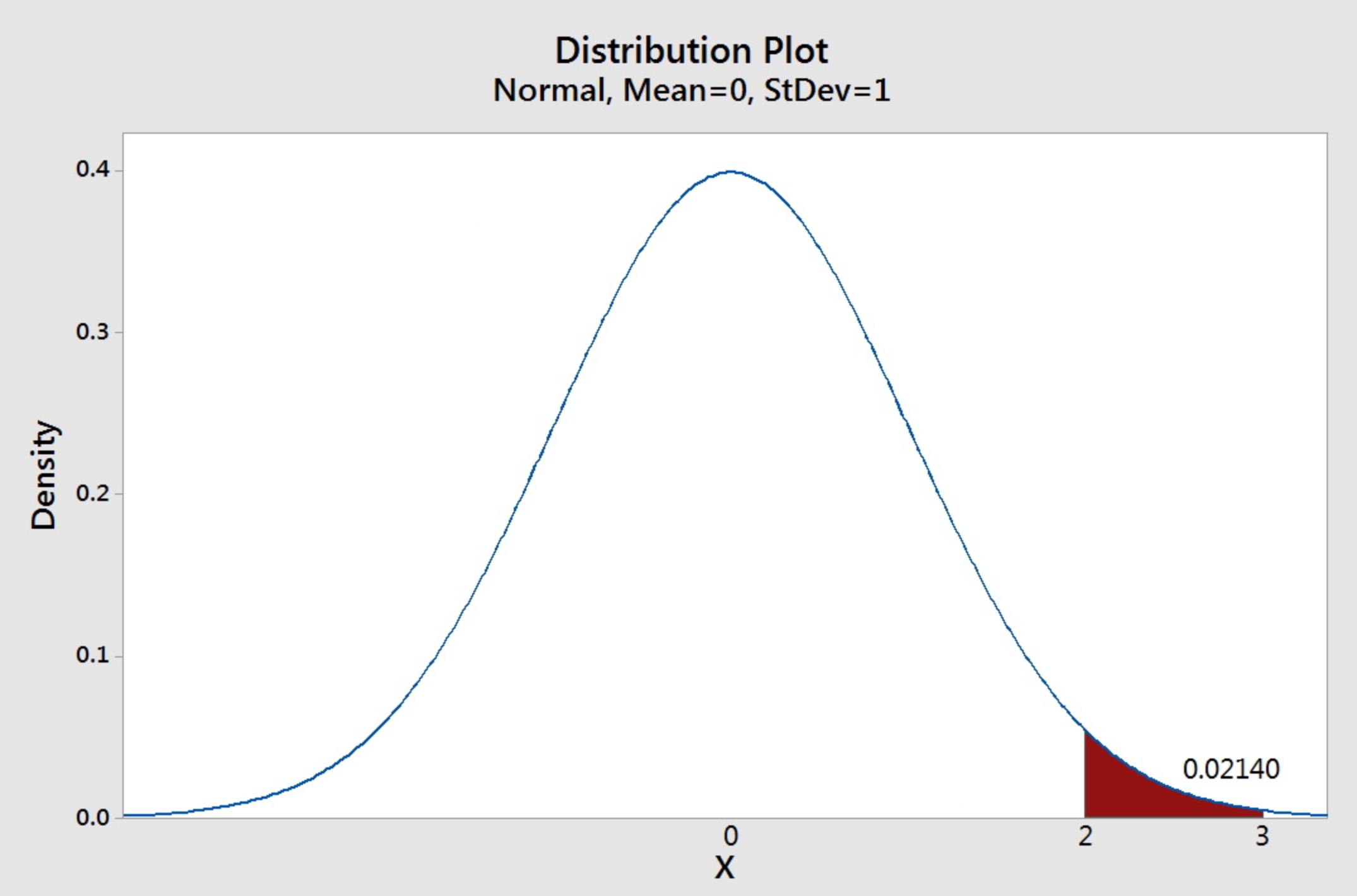
Percentiles of the Standard Normal Distribution Section
Recall from Lesson 1 that the \(p(100\%)^{th}\) percentile is the value that is greater than \(p(100\%)\) of the values in a data set. We can use the standard normal table and software to find percentiles for the standard normal distribution.
The intersection of the columns and rows in the table gives the probability. If we look for a particular probability in the table, we could then find its corresponding Z value.
Example 3-12: Percentiles in the Standard Normal Distribution Section
Find the 10th percentile of the standard normal curve.
The question is asking for a value to the left of which has an area of 0.1 under the standard normal curve.
Since the entries in the Standard Normal Cumulative Probability Table represent the probabilities and they are four-decimal-place numbers, we shall write 0.1 as 0.1000 to remind ourselves that it corresponds to the inside entry of the table. We search the body of the tables and find that the closest value to 0.1000 is 0.1003. We look to the leftmost of the row and up to the top of the column to find the corresponding z-value.
The corresponding z-value is -1.28. Thus z = -1.28.
z | .00 | .01 | .02 | .03 | .04 | .05 | .06 | .07 | .08 | .09 |
|---|---|---|---|---|---|---|---|---|---|---|
-1.3 | 0.0968 | 0.0951 | 0.934 | 0.0918 | 0.0901 | 0.0885 | 0.0869 | 0.0853 | 0.0838 | 0.0823 |
-1.2 | 0.1150 | 0.1131 | 0.1112 | 0.1093 | 0.1075 | 0.1056 | 0.1038 | 0.1020 | 0.1003 | 00985 |
-1.1 | 0.1357 | 0.1335 | 0.1314 | 0.1292 | 0.1271 | 0.1251 | 0.1230 | 0.1210 | 0.1190 | 0.1170 |
-1.0 | 0.1587 | 0.1562 | 0.1539 | 0.1515 | 0.1492 | 0.1469 | 0.1446 | 0.1423 | 0.1401 | 0.1379 |
Therefore, the 10th percentile of the standard normal distribution is -1.28.
Using Minitab
To find the 10th percentile of the standard normal distribution in Minitab...
- Select Calc> Probability Distributions> Normal.
- In the new window choose Inverse Cumulative Probability.
- Enter 0.1 in the Input constant box.
- Click OK.
You should see a value very close to -1.28.
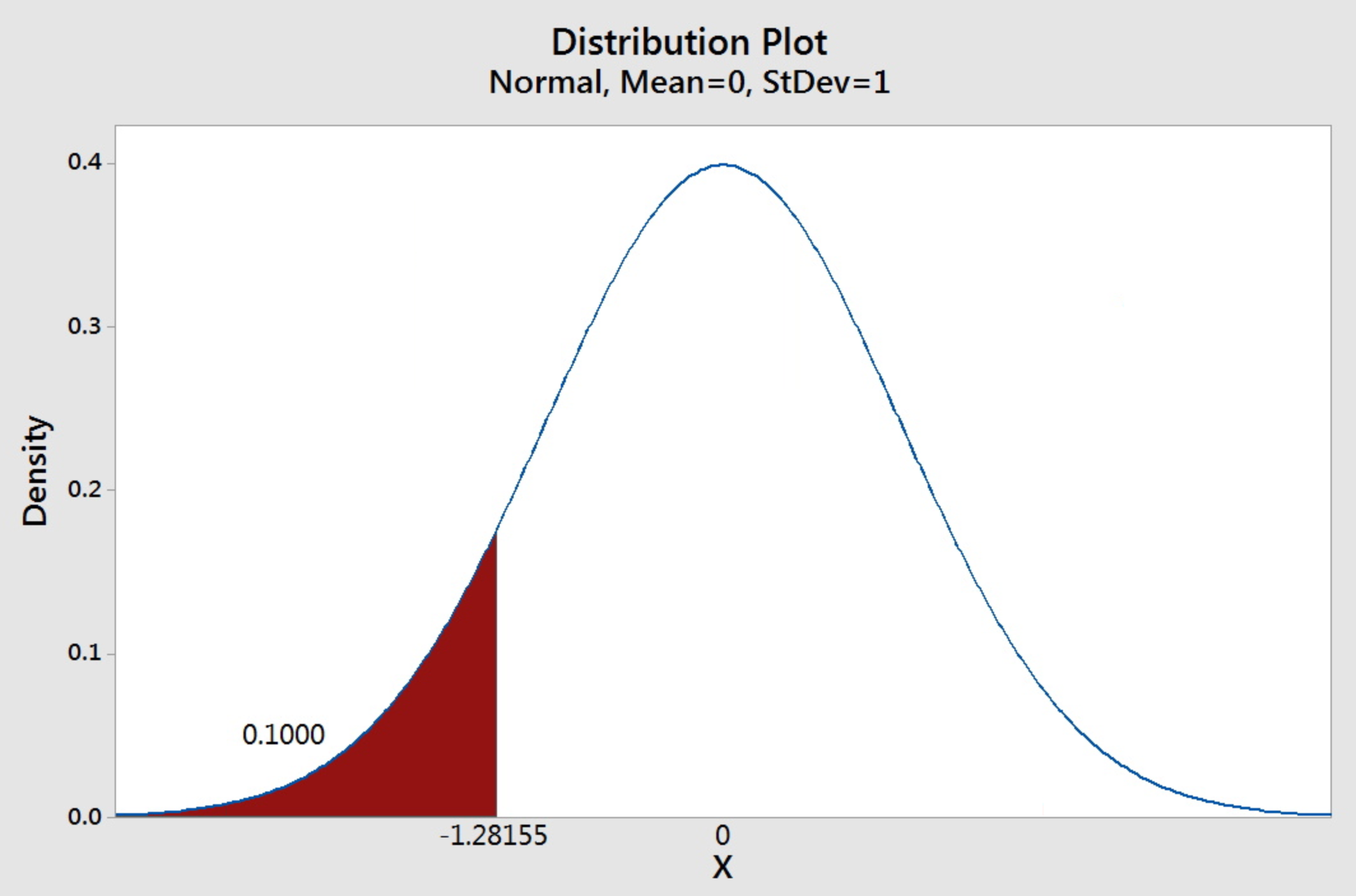
Minitab® – Normal Distribution with Minitab
Consider an alternative approach to calculate cumulative probabilities and normal percentiles in Minitab. Additionally, find the instructions for the same computations using the standard normal table for comparison.
Cumulative Probability
Suppose X has a Normal distribution with mean=10 and variance=4, and we want to find a Cumulative Probability: For example, find \(P(X≤12)\):
\(P(X≤12)=P(Z≤\dfrac{12-10}{\sqrt{4}})=P(Z≤1)=0.8413\)
Minitab Method 1 [Graph]:
- Select Graph > Probability Distribution Plot>View Probability > Normal (set the mean = 0 and variance = 1).
- In Options, select 'A specified value', 'Left Tail', and X-value: 1
- Select OKand OK
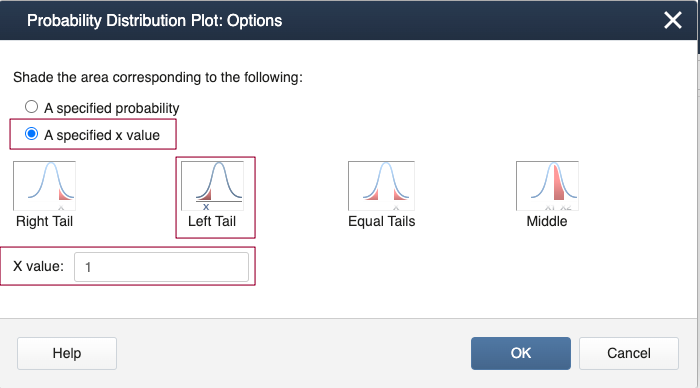
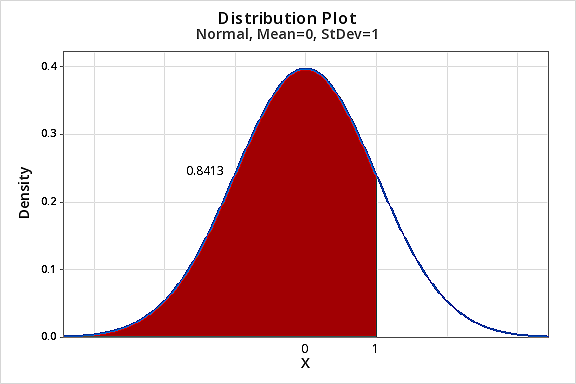
Minitab Method 2 [Calc]:
- Select Calc > Probability Distributions>Cumulative Distribution Function...
- Select 'A single value', Value = 1, Distribution = Normal, Mean = 0 and Standard deviation = 1.
- Select OK
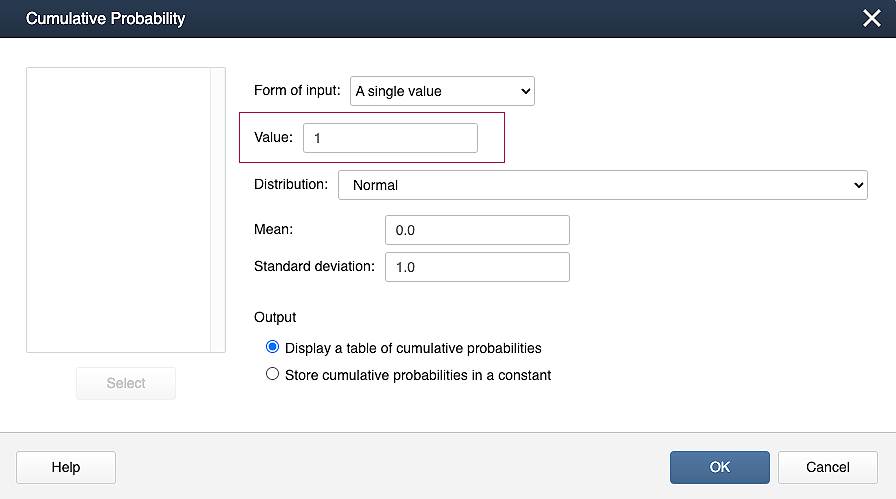
Binomial with n= 3 and p = 0.2
|
x |
P(X≤x) |
|---|---|
|
1 |
0.841345 |
You can read the z-score from the table only to two decimal places. Read up to 1st decimal in the 1st column and the second decimal from the corresponding column as shown below.
|
z |
.00 |
.01 |
.02 |
.03 |
.04 |
.05 |
.06 |
|---|---|---|---|---|---|---|---|
|
0.6 |
.7257 |
.7291 |
.7324 |
.7357 |
.7389 |
.7422 |
.7454 |
|
0.7 |
.7580 |
.7611 |
.7642 |
.7673 |
.7704 |
.7734 |
.7764 |
|
0.8 |
.7881 |
.7910 |
.7939 |
.7967 |
.7995 |
.8023 |
.8051 |
|
0.9 |
.8159 |
.8186 |
.8212 |
.8238 |
.8264 |
.8289 |
.8315 |
|
1.0 |
.8413 |
.8438 |
.8461 |
.8485 |
.8508 |
.8531 |
.8554 |
Therefore, the probability below a Z score of 1 is 0.8413.
Inverse Cumulative Probability
For example, say we want to find the 10th percentile of a normal distribution with a mean = 10 and a variance = 4.
Step 1:
Find the 10th percentile for a standard normal distribution.
That is \(z^*\) find such that \(P(Z≤z^*)=0.10\)→\(z^*=-1.282\)
Minitab Method 1 [Graph]:
- Select Graph > Probability Distribution Plot>View Probability > Normal (set the mean = 0 and variance = 1).
- In Options, select 'A specified value', 'Left Tail', and X-value: 1
- Select OK and OK
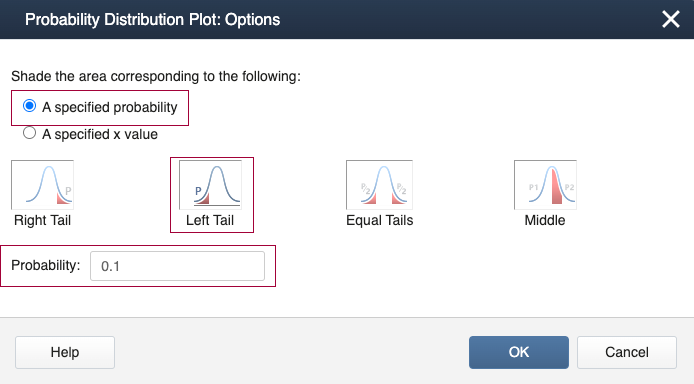
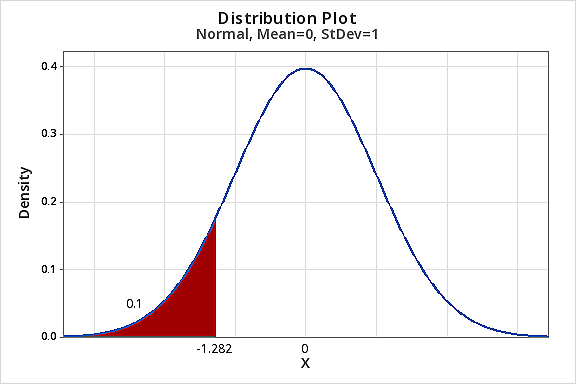
Minitab Method 2 [Calc]:
- Select Calc > Probability Distributions> Inverse Cumulative Distribution Function...
- Select 'A single value', Value = 1, Distribution = Normal, Mean = 0 and Standard deviation = 1.
- Select OK

Normal with mean = 0 and standard deviation = 1
|
x |
P(X≤x) |
|---|---|
|
0.1 |
-1.28155 |
Remember inside the table you have cumulative probabilities. So, you have to look for 0.1 cumulative probability in the table. Since the exact value is not in the table you read the closest value which is 0.1003. Now go to the margins to read the relevant z-score as shown below.
|
z |
.00 |
.01 |
.02 |
.03 |
.04 |
.05 |
.06 |
.07 |
.08 |
.09 |
|---|---|---|---|---|---|---|---|---|---|---|
|
-1.3 |
0.0968 |
0.0951 |
0.934 |
0.0918 |
0.0901 |
0.0885 |
0.0869 |
0.0853 |
0.0838 |
0.0823 |
|
-1.2 |
0.1150 |
0.1131 |
0.1112 |
0.1093 |
0.1075 |
0.1056 |
0.1038 |
0.1020 |
0.1003 |
00985 |
|
-1.1 |
0.1357 |
0.1335 |
0.1314 |
0.1292 |
0.1271 |
0.1251 |
0.1230 |
0.1210 |
0.1190 |
0.1170 |
|
-1.0 |
0.1587 |
0.1562 |
0.1539 |
0.1515 |
0.1492 |
0.1469 |
0.1446 |
0.1423 |
0.1401 |
0.1379 |
Step 2:
Back transform to the original scale.
Now that we have the z-score back transform as below:
\(x^*=10-1.28×2=10-2.56=7.44\)
